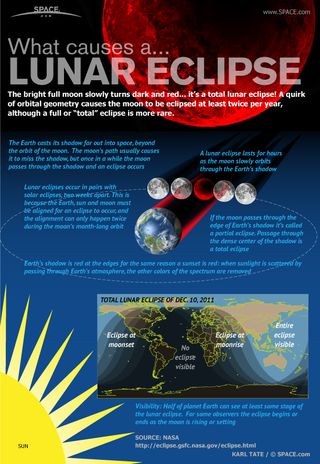How Flat-Earthers Explain Total Lunar Eclipses
The blood-red color of the moon during a total lunar eclipse may be difficult to explain without a basic understanding of orbital mechanics, but flat-Earth conspiracy theorists have come up with a way to circumvent scientific facts and construct a creative explanation of the phenomenon.
During the Super Blood Wolf Moon this weekend (Jan. 20-21), skywatchers in much of the Western Hemisphere saw the moon pass directly through Earth's shadow. Our natural satellite appears red during lunar eclipses for the same reason that sunrises and sunsets appear that shade here on Earth: because sunlight is scattered as it passes through the atmosphere.
According to flat-Earth conspiracy theorists, this astronomical phenomenon — known as a total lunar eclipse — was actually a rare opportunity to catch a glimpse of a mysterious "shadow object" that orbits the sun and occasionally passes in front of the moon from our point of view here, on an allegedly pizza-shaped Earth. [Amazing Photos of the Super Blood Wolf Moon of 2019!]
Although flat-Earthers believe our planet is flat as a pancake, they surprisingly seem to have come to the consensus that the sun and moon are spherical objects. However, these theorists posit that both the sun and the moon orbit Earth's north pole, hovering directly above the pancake and never passing around to the other side. If that were true, however, lunar eclipses as we know them could not happen, because the moon must be on the opposite side of the Earth from the sun for such an event to happen. So, flat-Earthers fabricated a new explanation for the shadow seen on the moon during an eclipse.
In a post on The Flat Earth Wiki, a website run by The Flat Earth Society, the conspiracy theorists offer no description of the so-called "shadow object" — no details about its size, shape, composition or origin. But the writers claim that this mysterious, shadowy figure causes all lunar eclipses. Oh, and it's totally invisible when it's not in front of the moon.

"The shadow object is never seen in the sky, because it orbits close to the sun," says The Flat Earth Wiki. Even though the tiny, innermost planet Mercury can be seen close to (and occasionally in front of) the sun, The Flat Earth Wiki falsely asserts that "we are never given a glimpse of the celestial bodies which appear near the sun during the day."
If nothing else, The Flat Earth Wiki does give a description of the mysterious proposed object's orbit, stating that it's tilted about 5.15 degrees to the sun's orbital plane. Coincidentally, in reality, this is the angle at which the moon's orbit is tilted with respect to Earth's orbit. The Flat Earth Society did not provide the mathematical calculations by which it arrived at this number, which seems more likely to have been "borrowed" from real astronomers' calculations than to have been derived from scratch.
Get the Space.com Newsletter
Breaking space news, the latest updates on rocket launches, skywatching events and more!
The wiki additionally states that "there is also a possibility that the Shadow Object is a known celestial body which orbits the sun; but more study would be needed to track the positions of Mercury, Venus and the sun's asteroid satellites and correlate them with the equations for the lunar eclipse before any conclusion could be drawn."
Astronomers have already charted the orbits of all the planets for the foreseeable future, and none of them will come in between Earth and the moon anytime soon (or ever).
Clearly The Flat Earth Society's explanation of the lunar eclipse is flat-out wrong. You can read more about the amazing math and physics of lunar and solar eclipses here. And don't worry if you missed the Super Blood Wolf Moon; here's when the next eclipses will occur.
Email Hanneke Weitering at hweitering@space.com or follow her @hannekescience. Follow us on Twitter @Spacedotcom and on Facebook. Original article on Space.com.
Join our Space Forums to keep talking space on the latest missions, night sky and more! And if you have a news tip, correction or comment, let us know at: community@space.com.

Hanneke Weitering is a multimedia journalist in the Pacific Northwest reporting on the future of aviation at FutureFlight.aero and Aviation International News and was previously the Editor for Spaceflight and Astronomy news here at Space.com. As an editor with over 10 years of experience in science journalism she has previously written for Scholastic Classroom Magazines, MedPage Today and The Joint Institute for Computational Sciences at Oak Ridge National Laboratory. After studying physics at the University of Tennessee in her hometown of Knoxville, she earned her graduate degree in Science, Health and Environmental Reporting (SHERP) from New York University. Hanneke joined the Space.com team in 2016 as a staff writer and producer, covering topics including spaceflight and astronomy. She currently lives in Seattle, home of the Space Needle, with her cat and two snakes. In her spare time, Hanneke enjoys exploring the Rocky Mountains, basking in nature and looking for dark skies to gaze at the cosmos.
Most Popular
